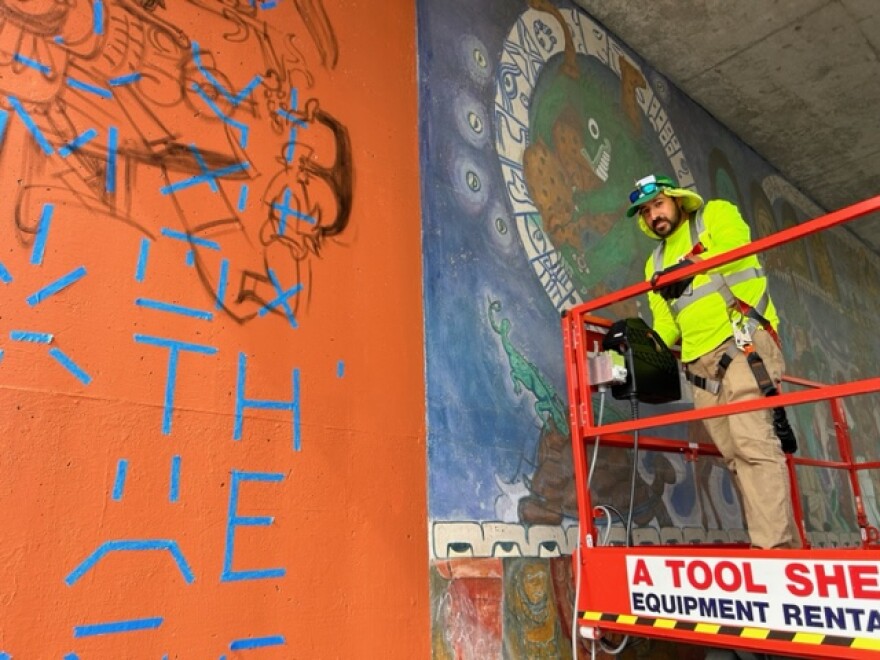The City of Salinas is advocating for more public art through funding and partnerships. Local artists and leaders say it’s a key part of the city’s identity.
Supporting public art has been a priority for Salinas for a few years now. After the completion of a public arts plan in 2017, the city council established a public art commission — and with that, a public art municipal fund.
Jose Arreola is the mastermind of the Salinas Public Arts Master Plan. “We have a vibrant art community that was looking for resources. It wasn't very well-resourced, and we wanted more partnerships and more city-led opportunities for public art,” Arreola said.
Arreola is the city’s Community Safety administrator, and leads a committee for the Public Arts Commission. “Public art is a relatively newer hat. I've had it for about three years now,” he said.
The city recently won a grant from Caltrans for mural projects on three underpassess of Highway 101, which bisects Salinas.
“And there was this large call for artists,” said Arreola. “And you know, funding for that project is in the hundreds of thousands, which is really neat. We have to be creative in how we look for funding.”
The funds are then made available to artists through a grant process. But, Arreola said, a lot of artists are not well equipped to navigate the bureaucracy of grants.
“The challenge is making sure that how we work with artists is equitable and accessible and prioritizes them,” he said.
Arreola took me on a tour of some of the city’s murals. We visited a part of the city called the Alisal, which was annexed in the 1960s and never quite got the level of care or resources the rest of the city did. The city is now hoping to change that through what they call the Alisal Vibrancy Plan.
“And a big part of that is art,” he said.
As we drove through the East Alisal Street freeway underpass, we saw a group of people sketching designs for new murals.
“Oh, look at that. They put the stenciling down for the new art. That's beautiful,” he said.
Arreola said 80 percent of Salinas is Latino, and the art, music, and performances reflect that — like the imagery on one of East Alisal Street’s existing murals, which features a large Aztec calendar.
We saw five artists working — a few on a scissor lift sketching the new design with black spray paint next to the older, existing mural, and another priming the underpass entry side a vibrant burnt orange. They’re a Monterey-based group called La Neta Murals. Natalia Corazza is one of the artists.
“This particular underpass is special because there's already two pre-existing murals that were made by two different artists at two different times,” Corazza said.
They had to add their design to the existing mural in a cohesive way, she said. A big part of that was through local feedback, which they gathered at a community engagement event back in November.
“So we did add some things based on that event. And it was also cool to get to know the community and be like, You know what? We want to do this for you more than anyone,” she said.
It was great to have the mural come to fruition after a year of planning, she said. The group attended a workshop the city offered to learn how to do a proper proposal, which she said was very helpful. La Neta Murals formed in 2020 and are still new to the game.

“You only learn through experience, so it was cool to be able to do that,” she said. “And even seeing us up here is a learning opportunity for other artists to see, you know, what are they doing? Like, how are they doing it?”
This engagement with local artists is a key part of the city’s Public Arts Master Plan. Jose Arreola said the city wants to make the application process smoother to encourage more local artists to apply for future projects.
“What could we be doing to make the application process easier or more attainable for our local artists? Could we do more training?” Arreola wondered.
Simplifying the grant process and training artists in that process is important, but the real challenge comes down to funding the arts program. Arreola said it's been getting less than $10,000 a year for the past few years.
But, this year, the public art commission requested a major funding increase…and they got it. Just this week, the city council approved their new budget, allocating an additional $100,000 to the Municipal Art Fund.
“Which was basically going from rags to riches like overnight,” he said.
As Arreola said, there are plenty of local artists who can make use of that money — for the benefit of all of Salinas.









